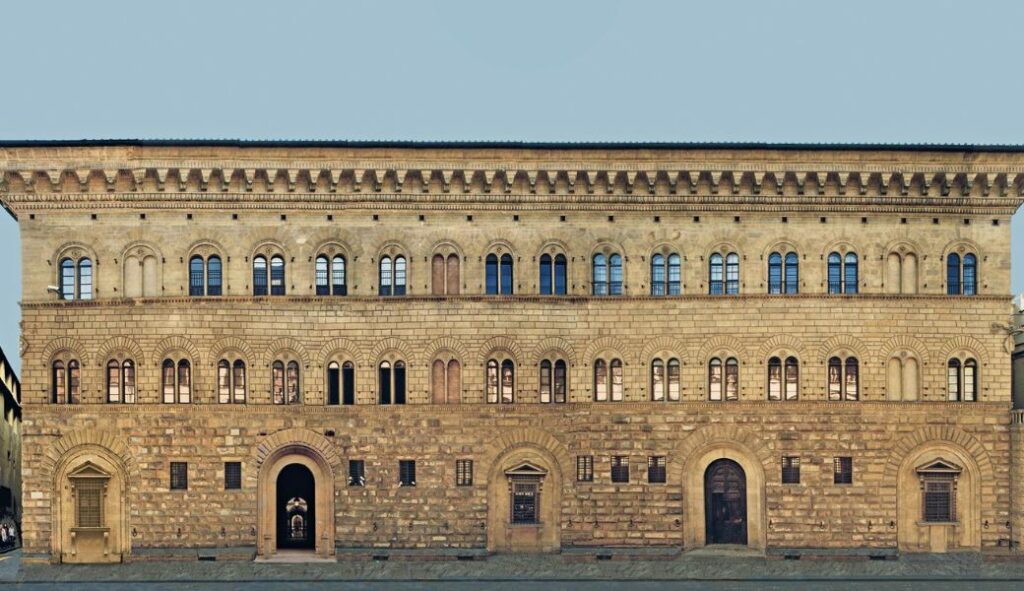Florence has countless architectural beauties and many other buildings of historical importance not only for the city, but for the world. One such building is the Palazzo Medici Riccardi, which was the first home of the Medici, where Cosimo The Older and Lorenzo The Magnificent lived.
There, an important part of the history of Florence took place, which can even be seen in the I Medici series, of which we talk about here. Through its rooms and corridors, in addition to the magnificent central courtyard, important personalities of Florentine history passed: Galeazzo Maria Sforza, portrayed in the Magi Chapel by Benozzo Gozzoli (1459) with members of the Medici family, was one of them.
Artists such as Donatello, Michelangelo, Paolo Uccello, Benozzo Gozzoli and Botticelli worked inside the Medici Riccardi Palace, which we can call with no mistake by the “home of the Renaissance”, where it all began.
The history of the Palace
Commissioned in 1444 by Cosimo the Elder, the residence of the Medici family is a fundamental model of Renaissance civil architecture. The first project was made by Filippo Brunelleschi, but Cosimo judget it as “too sumptuous and magnificent” such as to “bring him envy among his citizens rather than grandeur and ornament for the city, or comfort in itself” (G. Vasari, 1568). So, the construction was to the architect Michelozzo, who created the building we know today.
After the in insurrectionary movement headed by the Dominican friar Girolamo Savonarola, the Medici Riccardi Palace was confiscated along with all the family assets contained therein by the new government. The Medici were driven out of Florence and works such as Donatello’s David and Judith were transferred to the Palazzo della Signoria, the seat of the newborn Republic.
But the Medici were not defeated and returned to Florence in 1512 and came back to the Medici Riccardi Palace. The family remained living there until 1540, when the young Duke Cosimo I dei Medici decided to move to the considered more strategic Palazzo della Signoria.
The Riccardis
You may be asking yourself why the palace is called Medici Riccardi, if it belonged only to the Medici family. It is because in 1659 the palace was sold to the Marquis Gabriello Riccardi for forty thousand scudi. He enlarged it towards the north and restructured the interiors with sumptuous interventions in the Baroque style.
The construction of the so-called “Gallery” belongs to this period, the vault being splendidly decorated by the greatest Baroque painter of the time, Luca Giordano (1682-1685), with a fresco representing the Apotheosis of the Medici.
The rapid economic decline of the family, due to a luxurious lifestyle and waste of money, led the Riccardis to have to give the building to the state property in 1814, which made it the seat of the administrative offices, until 1874 when the building was purchased from the Province of Florence (today Metropolitan City), still operating in the building together with the Prefecture and the Historical Institute of the Resistance in Tuscany.
The museum itinerary
Basement:
ARCHAEOLOGICAL ROUTE
The underground rooms, formerly a Medici stable, then Riccardian cellars, today take on a new and authoritative dignity by combining contemporary architecture with testimonies of the past.
MARBLE MUSEUM
Opened to the public in 2005, the Marble Museum bears witness to the Riccardi family’s predilection for collecting ancient art.
Ground floor
MICHELOZZO COURTYARD (1444-1452)
Built to a design by Michelozzo, the elegant Renaissance courtyard is characterized by classical elements.
MEDICAL GARDEN
An essential element of the family’s private life is the Limonaia, an environment embellished with eighteenth-century stuccos and decorations.
EXHIBITION SPACES
In addition to the museum itinerary, the palace is home to temporary exhibitions set up in the historic rooms of the Medici museum.
First floor
CHAPEL OF THE MAGI (1459-1561)
The procession of the Magi, masterfully frescoed by Benozzo Gozzoli, portrays members of the Medici family with illustrious men.
MADONNA WITH CHILD (1466-1469)
The Madonna by Filippo Lippi, depicted while leaning towards her son, is among the late works of the Florentine master.
LUCA GIORDANO GALLERY (1682-1691)
The decoration of the mirrors dialogues with the majestic vault frescoed by Luca Giordano depicting the Apotheosis of the Medici.

